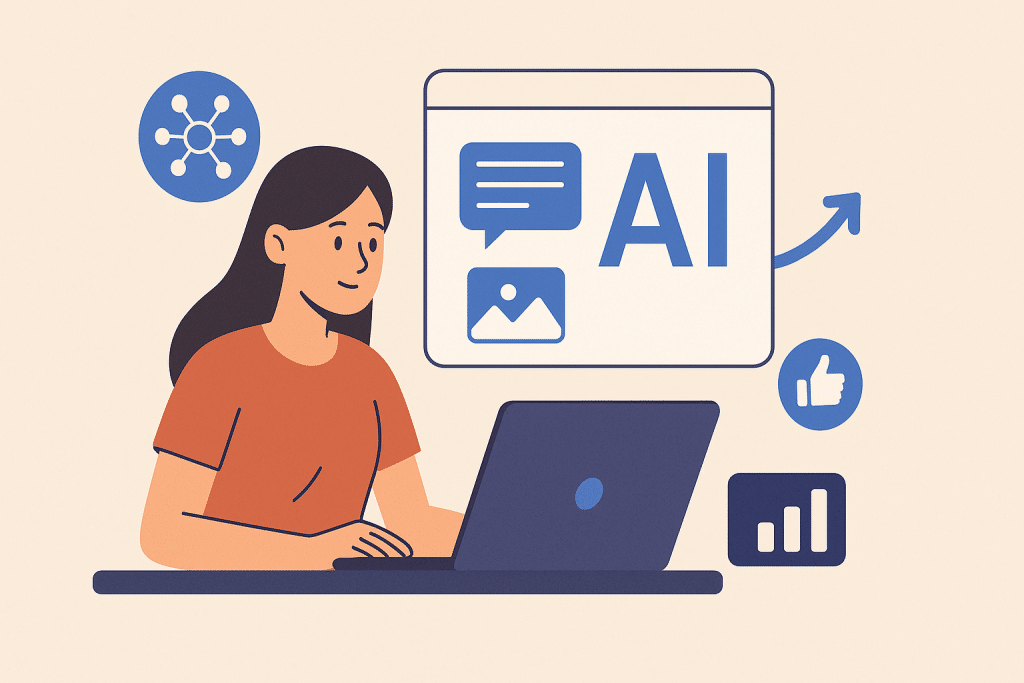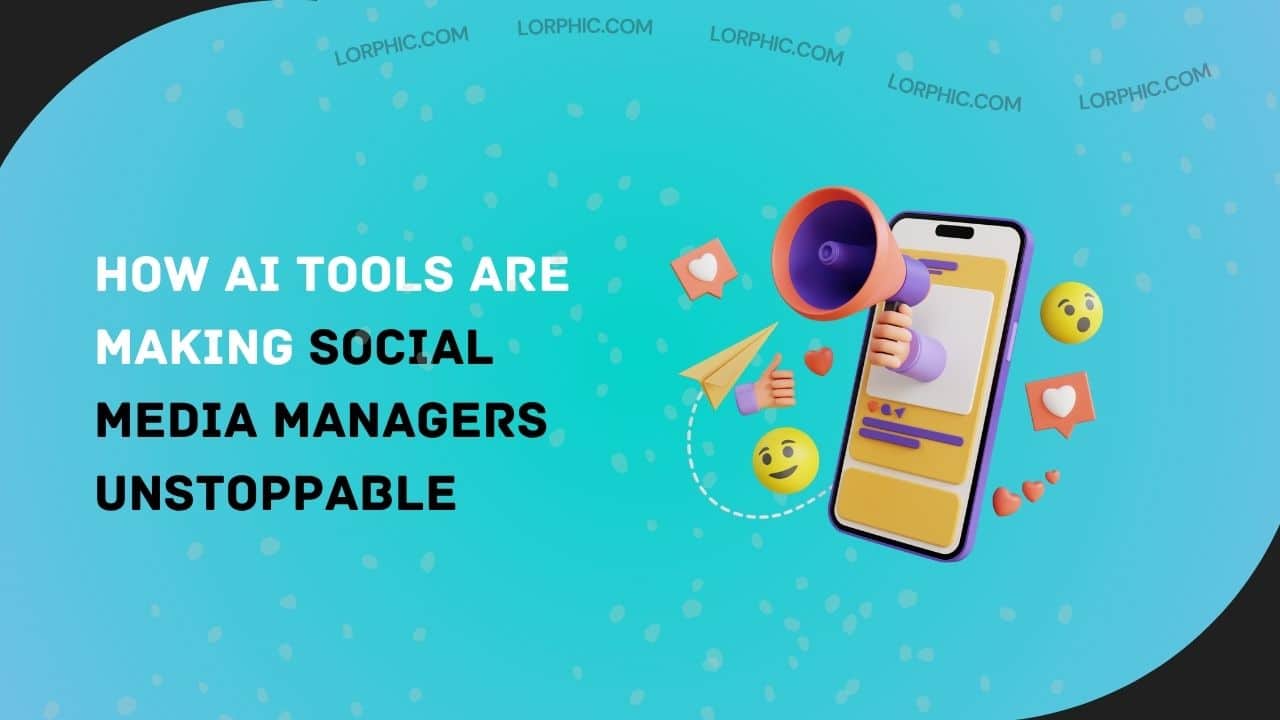In today’s digital world, social media is no longer a “nice to have” it’s a strategic frontline. But managing it well is harder than ever: more platforms, more formats, more expectations. Enter artificial intelligence (AI) tools – and if you’re a social media manager (or someone who wears that hat), they are rapidly transforming how you work. This isn’t about “robots replacing people” (we’ll get to that). It’s about how smart tools are making social media managers faster, smarter, and more effective.
In this piece, we’ll explore why this transformation is happening, how it works (step-by-step process), what it means in practice, and what you need to do to leverage it. By the end you should feel equipped not intimidated to embrace AI tools in your social media workflow.

The Big Impact: Why AI changes the game
1. Efficiency gains
One of the most immediate effects: tasks that used to take a lot of manual time now take far less. For example: generating captions, scheduling posts, choosing hashtags, doing basic analytics. AI tools can automate large parts of these workflows, freeing up time for higher-value work.
2. Smarter decisions with data
Social media generates massive amounts of data: views, likes, shares, comments, click-throughs. AI can sift through that, spot patterns, and present insights. For example: which posts resonate more, what times are best to publish, what topics your audience cares about.
3. Creativity at scale
AI doesn’t replace creativity it augments it. It can suggest post ideas, generate variations (text, image, even video), repurpose older content, suggest designs. This allows a social media manager to run at a volume and speed previously impossible.
4. Personalisation and relevancy
Audiences expect content that feels relevant to them. AI can help by analysing audience behaviour and tailoring content accordingly (tone, topic, format). Studies on AI-driven personalization in digital communication show this approach makes posts feel less “broadcast” and more “conversation”.
5. Competitive edge
Because many brands are still catching up, adopting AI tools early can put a social media manager ahead of the curve. Better results, faster turnaround, more strategic focus → value increases.
6. New risks and responsibilities
It’s not all upside. With great power comes new responsibilities: risk of losing authenticity, over-automation, privacy concerns, ethical questions, job-role shifts.
In short: AI is transforming the job of a social media manager from doing lots of manual tasks into strategising, creating, analysing and making an impact.
The Process: How AI tools are applied, step by step
Here’s a breakdown of how a social media manager might adopt and use AI tools in a systematic way.
- Define the objectives
- What are your social media goals? (brand awareness, engagement, conversion, community growth)
- Which key performance indicators (KPIs) matter? (likes, shares, comments, clicks, sign-ups)
- What constraints do you have? (budget, team size, platforms)
- Audit current workflow
- Map out your existing tasks: content ideation, creation, posting, monitoring, reporting.
- Identify repetitive, low-value tasks.
- Identify bottlenecks (e.g., “We spend 4 hours a week drafting posts”, “We struggle with consistency”, “We don’t have time to analyse data”).
- Select the right AI tools
- Choose tools with the features you need: e.g., generative text/image capabilities, scheduling/automation, analytics/insights.
- Consider budget, ease of use, integration with your platforms (Instagram, X, LinkedIn, TikTok etc).
- Involve your team; get buy-in.
- Pilot in a controlled way
- Run a short-term pilot: pick one platform or content type.
- Use the AI tool for a few weeks and monitor results: time saved, engagement changes, workflow changes.
- Evaluate: What worked? What didn’t?
- Integrate into workflow
- Based on pilot results, roll out to broader use: more platforms, more content types.
- Define clear roles: AI tool handles certain tasks (e.g., draft captions, suggest hashtags), human handles others (final edit, voice, strategy).
- Document the process: create SOPs (standard operating procedures) for how and when the AI tool is used.
- Create and schedule content
- Use AI to generate post ideas, draft content, suggest images/designs.
- Review/edit to ensure brand voice and authenticity.
- Schedule via your social media management platform (many integrate AI).
- Track and optimise: use analytics to pick best times, formats, topics.
- Analyse and optimise
- After publication, gather performance data: reach, engagement, conversions.
- Use AI-driven analytics to spot patterns (e.g., posts with video get 30% more comments, content on topic X gets more shares). Marketing AI Institute research demonstrates how these data-driven insights help managers optimize their content strategy in real-time.
- Adjust strategy: shift content types, timing, formats.
- Continue iteration: the best social media strategies evolve continuously.
- Ensure ethics, authenticity and human oversight
- Even the best AI-generated post still needs human review: voice, context, authenticity.
- Be transparent when needed (e.g., disclaimers if content is AI-generated).
- Monitor for bias, privacy issues, compliance with platform policies.
Real-world Example in Practice
Let’s walk through a realistic example of a social media manager (let’s call her “Maria”) in a mid-size brand adopting AI tools.
- Maria’s brand target: increase engagement on Instagram and LinkedIn by 25% in 6 months.
- Workflow she audits: currently 3 posts/week on each platform, 2 hours content ideation + creation, 1 hour scheduling + tagging, minimal analytics deep dive.
- Bottlenecks: limited time, inconsistent posting, guesswork on what topics work.
- She selects an AI tool that can: generate post ideas aligned to brand, draft caption options, suggest hashtags, schedule posts and provide analytics.
- Pilot: She uses the tool for Instagram for 2 months: doubles number of post ideas, cuts caption‐writing time by 60%.
- Integration: She defines a process – each week:
- Use AI to generate 10 post ideas; pick 3.
- Use AI to draft captions; she edits voice.
- Use AI to propose best posting times; schedule.
- After posts go live, use AI analytics to review: which of 3 posts did best (in both platforms).
- After 3 months: engagement increases by 30% on Instagram, she shifts same process to LinkedIn.
- She keeps human oversight: she reviews every caption, ensures brand voice, interacts in comments (human touch).
- She tracks weekly metrics and adjusts: more carousel posts, fewer single-image posts; more posts at a slightly later evening time found to get more engagement.
This example shows how AI doesn’t replace Maria it empowers her. It lifts operational burden and frees her to focus on strategy, creativity and human connection.
Why Social Media Managers Are Now “Unstoppable”
Putting all of this together: what does it mean for a social media manager who embraces AI?
- Scale without burnout: You can handle more channels, more content, more campaigns without needing twice the team.
- Better performance: You base decisions on data, adapt faster, reach audiences more effectively.
- More strategic role: Because you’re freed from repetitive tasks, you can focus on brand story, community, deep engagement.
- Competitive differentiation: Many brands are still doing things the old way; by using AI you stand out.
- Evolving role future-proofing: As AI becomes integral, being fluent in these tools makes you more valuable.
In other words, instead of being constrained by time, manual tasks or guesswork, you’re being enabled to perform at a higher level. That’s why “unstoppable” is more than hype it’s a realistic outcome for social media managers who adopt these tools smartly.
How to Actually Use AI Without Losing Your Voice
Adopting AI as a social media manager isn’t about flipping a switch it’s about weaving it into your daily rhythm naturally. Here’s how it really works when done right:
- Start with clarity, not curiosity.
Before you try every shiny tool you see on LinkedIn, decide why you need AI. Are you trying to save time on captions, get better analytics, or post more consistently? When your purpose is clear, the tool becomes an extension of your workflow not an experiment that wastes your afternoon. - Integrate slowly, one pain point at a time.
Don’t automate everything overnight. Maybe begin by letting AI handle hashtags or caption drafts. Once you trust the quality, move to image suggestions or analytics summaries. This step-by-step integration keeps your content authentic and your workflow under control. - Keep your brand voice sacred.
AI can write fast, but it doesn’t know your audience like you do. Always review, tweak, and inject that tone that makes your posts “yours.” Think of AI as your intern talented, fast, but still needs your approval before anything goes live. - Use data to fuel your instincts.
AI analytics aren’t there to boss you around they’re there to confirm or challenge your gut feelings. Maybe you feel like your evening posts perform better; now you can see it in numbers. That’s how you evolve from guessing to precision. - Stay human in engagement.
Automation can’t replace that quick, witty reply or that heartfelt thank-you comment. Keep the conversations human. That’s where trust builds, and AI simply can’t fake it. - Audit regularly.
Every few weeks, take a step back and check: what’s working, what’s robotic, what’s still missing your human touch? Adjust. Evolve. The best social media managers never stop fine-tuning the mix of automation and authenticity.
When you do this, AI doesn’t erase your presence it amplifies it. You become faster without losing personality, strategic without losing spontaneity. That’s the sweet spot where social media managers truly become unstoppable.
Pitfalls to Avoid
Since you asked for depth, here are things many overlook:
- Over-automation = loss of authenticity: If everything feels robotic, your audience will sense it. Human voice still matters.
- Ignoring data: Some tools give lots of data if you ignore it, you miss opportunities.
- Choosing the “wrong” tool: One size doesn’t fit all. If the tool doesn’t integrate or doesn’t suit your workflow, you’ll drag.
- Neglecting ethics & transparency: AI-generated content may raise questions of authenticity, consent, bias.
- Failing to train your team: It’s not enough to install a tool; you and your team need to learn how to use it well.
- Treating AI as a substitute for strategy: A tool is an enabler, not a replacement. Your human judgement defines success.
Future Outlook: What’s Next
Here are trends worth watching, so you’re prepared:
- More predictive analytics: AI will increasingly tell you what will work before you publish.
- More generative content (text + image + video) being produced, and social media managers will need to oversee it.
- More focus on audience authenticity and community building, as algorithmic reach becomes more competitive.
- Greater emphasis on ethics, brand safety, and transparency: as audiences become more aware of AI-generated content, trust will be vital.
- Social media manager roles will shift: less posting, more strategy, more oversight of AI workflows. So staying ahead of these changes is to your advantage.
Final Thoughts
If you’re a social media manager (or you manage the social presence of a brand), the rise of AI tools isn’t a threat it’s an opportunity. The process I’ve outlined gives you a path: define, audit, pilot, integrate, analyse, iterate. The impact is already real: more efficiency, better decisions, smarter content. But to make it work, you must stay human retain authenticity, apply strategy, and oversee the tools.
By doing this, you’ll not just keep pace you’ll become unstoppable.
Curated by Lorphic
Digital intelligence. Clarity. Truth.




